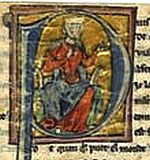Marie of France, Countess of Champagne
| Marie of France | |
|---|---|
Capet | |
| Father | Louis VII of France |
| Mother | Eleanor of Aquitaine |
Marie of France (1145 – 11 March 1198) was a
Early life
Marie's birth was hailed as a "miracle" by Bernard of Clairvaux, [1] an answer to his prayer to bless the marriage between Eleanor of Aquitaine and Louis VII. [2] Marie was just 2 years old when her parents joined the Second Crusade to the Holy Land. With the birth of her sister Alice in 1150 instead of the desperately needed son and heir the couple hoped for, the marriage broke down and was annulled on 21 March 1152; Marie was 7 and Alice was not yet 2. [3] Custody of the girls was awarded to their father as they were at that time the only heirs to the French throne. Eleanor quickly moved on, marrying Henry, Duke of Normandy, on 18 May. Louis married Constance of Castile in 1154. Just 5 weeks after Constance died while giving birth to their second child and daughter, he married Adele of Champagne on 13 November 1160, who gave birth to Philippe in 1165.
Marriage
In 1153, Marie was betrothed to Henry of Champagne by her father Louis.
Regencies
Marie became regent for Champagne when her husband Henry I went on pilgrimage to the Holy Land from 1179 until 1181. While her husband was away, Marie's father died and her half-brother,
Marie, who had retired to the nunnery of Château de Fontaines-les-Nonnes near Meaux (1187–1190), served again as regent for Champagne as her son Henry II joined the Third Crusade from 1190 to 1197. He remained in the Levant, marrying Queen Isabella I of Jerusalem in 1192. Over the course of her regencies, Champagne was transformed from a patchwork of territories into a significant principality.[3]
Literary patronage

Marie was a patron of literature and her court became a sphere of influence on authors and poets[7] such as Andreas Capellanus, who served in her court and referred to her several times in his writing, Chrétien de Troyes, who credits her with the idea for his Lancelot: The Knight of the Cart, the troubadours Bertran de Born and Bernart de Ventadorn, Gautier d'Arras and Conon de Bétune.[8]
Being literate in both French and Latin, she amassed and maintained her own extensive library.[3] Marie's half-brother King Richard, mentions her in a stanza from his celebrated poem J'a nuns hons pris, lamenting his captivity in Austria, was addressed to her.[9]
Death
Marie died on 11 March 1198, not long after hearing the news of her son's death.[3] She was buried in Meaux Cathedral.
On 25 June 1562, rioting Huguenots devastated many edifices, including the Cathedral of Meaux; it was on this occasion that the tomb of Marie of Champagne, located in the choir, was destroyed.[b]
Issue
Marie and her husband Henri I of Champagne had:
- Scholastique of Champagne (1172–1219), married William IV of Macon[11]
- Baldwin I of Constantinople[11]
- Theobald III of Champagne (1179–1201), married Blanche of Navarre[11]
Genealogical table
| Selective genealogy of Countess Marie[11] | |||||||||||||||||||||||||||||||||||||||||||||||||||||||||||||||||||||||||||||||||||||||||||||||||||||||||||||||||||||||||||||||||||||||||||||||||||||||||||||||||||||||||||||||||||||||||||||||||||||||||||||||||||||||||||||||||||||||||||||||||||||||||||||||||||||||||||||||||||||||||||||||||||||||||||||||||||||||||||||||||||||||||||||||||||||||||||||||||||||||||||||||||||||||||||||||||||||||||||||||||||||||||||||||||||||||||||||||||||||||||||||||||||||||||||||||||||||||||||||||||||||||||||||||
|---|---|---|---|---|---|---|---|---|---|---|---|---|---|---|---|---|---|---|---|---|---|---|---|---|---|---|---|---|---|---|---|---|---|---|---|---|---|---|---|---|---|---|---|---|---|---|---|---|---|---|---|---|---|---|---|---|---|---|---|---|---|---|---|---|---|---|---|---|---|---|---|---|---|---|---|---|---|---|---|---|---|---|---|---|---|---|---|---|---|---|---|---|---|---|---|---|---|---|---|---|---|---|---|---|---|---|---|---|---|---|---|---|---|---|---|---|---|---|---|---|---|---|---|---|---|---|---|---|---|---|---|---|---|---|---|---|---|---|---|---|---|---|---|---|---|---|---|---|---|---|---|---|---|---|---|---|---|---|---|---|---|---|---|---|---|---|---|---|---|---|---|---|---|---|---|---|---|---|---|---|---|---|---|---|---|---|---|---|---|---|---|---|---|---|---|---|---|---|---|---|---|---|---|---|---|---|---|---|---|---|---|---|---|---|---|---|---|---|---|---|---|---|---|---|---|---|---|---|---|---|---|---|---|---|---|---|---|---|---|---|---|---|---|---|---|---|---|---|---|---|---|---|---|---|---|---|---|---|---|---|---|---|---|---|---|---|---|---|---|---|---|---|---|---|---|---|---|---|---|---|---|---|---|---|---|---|---|---|---|---|---|---|---|---|---|---|---|---|---|---|---|---|---|---|---|---|---|---|---|---|---|---|---|---|---|---|---|---|---|---|---|---|---|---|---|---|---|---|---|---|---|---|---|---|---|---|---|---|---|---|---|---|---|---|---|---|---|---|---|---|---|---|---|---|---|---|---|---|---|---|---|---|---|---|---|---|---|---|---|---|---|---|---|---|---|---|---|---|---|---|---|---|---|---|---|---|---|---|---|---|---|---|---|---|---|---|---|---|---|---|---|---|---|---|---|---|---|---|---|---|---|---|---|---|---|---|---|---|---|---|---|---|---|---|---|---|---|---|---|---|---|---|---|---|---|---|---|---|---|---|---|---|---|---|---|---|---|---|---|---|---|---|---|---|---|---|---|---|---|---|---|---|---|---|---|---|---|---|---|---|---|---|---|---|---|---|---|---|---|---|---|---|---|---|---|---|---|---|---|---|---|---|---|---|---|
| |||||||||||||||||||||||||||||||||||||||||||||||||||||||||||||||||||||||||||||||||||||||||||||||||||||||||||||||||||||||||||||||||||||||||||||||||||||||||||||||||||||||||||||||||||||||||||||||||||||||||||||||||||||||||||||||||||||||||||||||||||||||||||||||||||||||||||||||||||||||||||||||||||||||||||||||||||||||||||||||||||||||||||||||||||||||||||||||||||||||||||||||||||||||||||||||||||||||||||||||||||||||||||||||||||||||||||||||||||||||||||||||||||||||||||||||||||||||||||||||||||||||||||||||
Notes
- ^ An 1159 charter refers to Marie as Trecensis comitissa indicating the marriage had taken place. The marriage date of 1164 is from Henri d'Arbois de Jubainville based on "a late and unreliable document".[5]
- ^ McCash state Protestants during the reformation destroyed Marie's tomb. She gives no dates.[10]
References
- ^ Seaman 2003, p. 8.
- ^ Kelly 1991, p. 126.
- ^ a b c d Evergates 2018, p. ?.
- ^ McCash 1979, p. 707.
- ^ McCash 2008, p. 15.
- ^ McCash 1979, p. 705.
- ^ Benton 1961, p. 551.
- ^ McCash 1979, p. 700.
- ^ a b McCash 1979, p. 704.
- ^ McCash 1979, p. 699.
- ^ a b c d e Evergates 2018, p. 109.
Sources
- S2CID 161184362.
- Evergates, Theodore (2018). Marie of France: Countess of Champagne, 1145-1198 (1st ed.). Philadelphia. OCLC 1033578543.)
{{cite book}}: CS1 maint: location missing publisher (link - Kelly, Amy Ruth (1991). Eleanor of Aquitaine and the Four Kings. Harvard University Press.
- McCash, June Hall Martin (1979). "Marie de Champagne and Eleanor of Aquitaine: A Relationship Reexamined". Speculum. 54.4 (Oct): 698–711.
- McCash, June Hall (2008). "Chrétien's Patrons". In Grimbert, Joan Tasker; Lacy, Norris J. (eds.). A Companion to Chrétien de Troyes. Boydell & Brewer.
- Seaman, Gerald (2003). Busby, Keith; Dalrymple, Roger (eds.). "Reassessing Chretien's Elusive Vanz". Arthurian Literature XX. D.S. Brewer.
